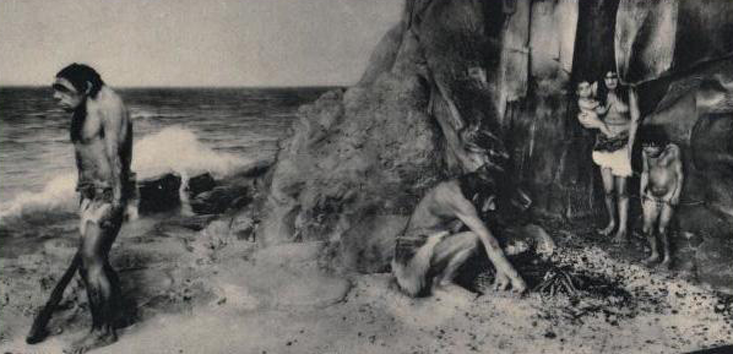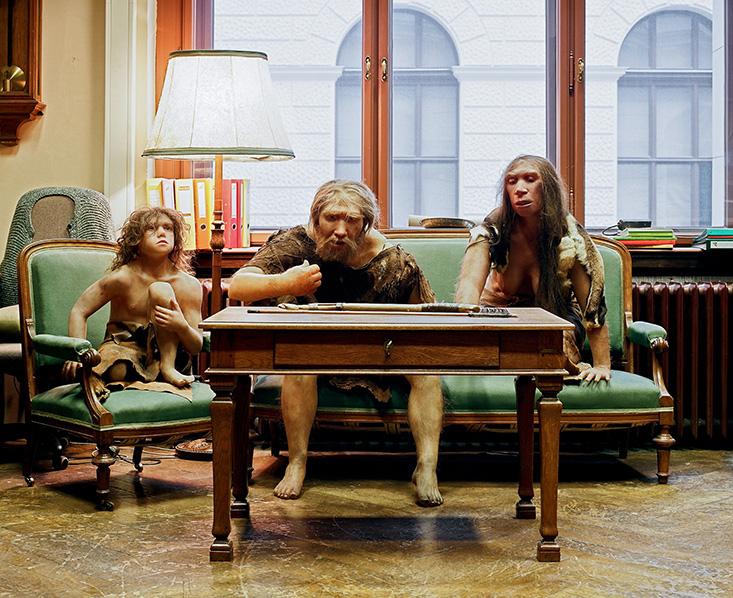In August 1856, limestone quarry workers blasting out the entrance to the Feldhofer grotto in the Neander Valley of west-central Germany found a set of skeletal remains. Assuming the skull scraps, arm bones, ribs, and pelvis were from an ancient cave bear, the workers turned them all over to Johann Carl Fuhlrott, an amateur naturalist and local schoolteacher. Fuhlrott quickly recognized that the bones were in fact human-like, but in an unusual way: The skull was extremely thick, elongated, and had almost ridiculously pronounced brow ridges.
In June 1857, together with the famed professor of anatomy Hermann Schaaffhausen, Fuhlrott publicly announced that the bones represented an ancient race of humans. “The human bones from the Neanderthal exceed all the rest of those peculiarities of conformation which led to the conclusion of their belonging to a barbarous and savage race,” the two researchers wrote.1 The unique cranial morphology of Neanderthals was immediately interpreted as issuing from deficiencies in Neanderthal cognitive ability, and by the beginning of the 20th century, this was taken as a given: New Neanderthal specimens discovered across Eurasia did little to dissuade the paleo-intelligentsia from this thesis.
Neanderthals created complex tools, buried their dead, had an organized use of space, probably cared for the infirm, and perhaps even conversed vocally.
In 1908, for example, a Neanderthal skeleton was uncovered in France, outside of La Chapelle-aux-Saints; it was recovered in situ, as a burial, and, as such, indicated some sort of non-primitive, cultural behavior. The skeleton was promptly sent off for analysis to Marcellin Boule, the Director of the Laboratory of Palaeontology at the prestigious Musee d’Histoire Naturelle. In his monograph, L’Homme Fossile de La Chapelle-aux-Saints, he concluded, not that the La Chapelle Neanderthal might have exhibited some signs of higher function, but that its severely curved spine, bent knees, jutting head, and low-vaulted cranium confirmed the primitive nature of the species.2 His interpretation of the La Chapelle fossil set the paradigm for Neanderthal research for the better part of a century.
This view was echoed by museums and dioramas. When the Field Museum of Natural History opened its Hall of the Stone Age of the Old World in 1933, the exhibit featured eight dioramas, each one focused on a different type of prehistoric human. One diorama called “The Mousterian” showed a group of five life-size Neanderthal figures in front of a rock shelter. The museum guidebook, Prehistoric Man, explained the role of each figure: The elder Neanderthal man by the fire was the group’s patriarch, his eldest son was standing guard, and so on. Although this scene humanized the behavior of Neanderthals, the guide left little to the imagination regarding the species’ intelligence: “the prefrontal area, which is the seat of the higher faculties, was not fully developed in [Neanderthals], and had a protuberance similar to that found in the brain of anthropoids [great apes]. Furthermore, the lobe associated with the power of speech was little developed…”

The rhetoric of the “savage” and “primitive” Neanderthal also informed the story of Neanderthal extinction, which happened 30,000 to 50,000 years ago.3 Purported causes have oscillated from changing climates and inferior technologies to the species’ hybridization, the advent of revolutionary cognition in Homo sapiens, and even a human-caused genocide. Many of these accounts assumed a lack of the ingenuity necessary for a species to be an evolutionary success—an ingenuity that Homo sapiens had. As the 1933 Field Museum’s Prehistoric Man put it, “Man, small in number and physically weak in comparison with the creatures which surrounded him, was forced to use ingenuity and his powers of reason, in order to maintain himself in a hostile world.”
Genius became the defining characteristic of humans’ evolutionary achievement, and the narrative against which Neanderthals were measured. Even the language of extinction imbued Neanderthals with an aura of evolutionary fatalism: “demise,” “fate,” and “loss” helped us cast our interspecies interaction as a relationship between winners and losers. “It is not difficult to understand why the Neanderthals failed to survive,” noted Richard Klein in the third edition of his seminal textbook, The Human Career, in 2009. “The archaeological record shows that in virtually every detectable aspect—artifacts, site modification, ability to adapt to extreme environments, subsistence, and so forth—the Neanderthals lagged their modern successors, and their more primitive behavior limited their ability to compete for game and other shared resources.”4
The only problem? Much of our understanding of the Neanderthals has turned out to be wrong.
In his critically-acclaimed Neanderthal Parallax trilogy, published in 2002 and 2003, science fiction author Robert Sawyer envisions an alternative evolutionary timeline. What if, in the glacial Pleistocene, Homo sapiens hadn’t beat out every other member of Homo? What if, instead, Neanderthals had spent the last 30,000 years achieving a culture as sophisticated as our own? What if Neanderthals did “human” better?
Sawyer’s plot might be far-fetched, but his vision of a blurred boundary between human and Neanderthal has increasingly become rooted in fact. By the 1960s, the first cracks appeared in the traditional “savage” and “primitive” Neanderthal narrative. Research that re-examined Boule’s original studies revealed that humans and Neanderthals had a very similar locomotor pattern; pollen found at the Shanidar burial in Iraq was interpreted as flowers placed on graves (though this was later disputed); and the distributions of ages and disabilities at the Shanidar site suggested a system of Neanderthal social support.5
By the 1990s and early 2000s, research had firmly established that Neanderthals created complex tools, buried their dead, had an organized use of space, probably cared for the infirm, and perhaps even conversed vocally. Over the last decade, a host of sites, like El Sidrón, Riparo Bombrini, and Mezmaiskaya Cave (in Spain, Italy, and Russia, respectively), have offered more evidence—like specialized living areas in rock shelters and complex tool technologies—to indicate that Neanderthals were capable of sophisticated behavior.6

Just this year, researchers offered a series of tantalizingly detailed new insights about Neanderthal culture and Pleistocene lifestyles. Paleo-geneticists have lit up the public imagination with descriptions of the genetic overlap between modern humans and Neanderthals.7 Excavations at Gorham’s Cave in Gibraltar have suggested that Neanderthals exploited rock pigeon populations8 for food and produced etched cave art9 around 39,000 years ago. Clive Finlayson, the director of the Heritage Division of the Gibraltar Museum and Gorham Cave researcher, noted in an interview in Nature, “What is clear is that it [the etched cave art] is abstract, it’s deliberate, and it speaks to their cognition in a way that brings Neanderthals, once again, closer to us.”
The new findings have ushered a transformation of the Neanderthal from a knuckle-dragging savage rightfully defeated in an evolutionary contest, to a distant cousin that holds clues to our identity. Where museums used to emphasize their primitive and brutal nature, modern exhibits evoke a feeling of belonging. “For Neanderthals, especially in museum exhibits, there’s a sense of wanting to connect to them since they are so close to us,” says Linda Kim, an art historian specializing in museum exhibits. “There’s a deep longing or perhaps a sense of kinfolk.”
“We see ourselves, for better or worse, in comparison to Neanderthals.”
The Hall of Human Origins at the Smithsonian Institution is a case in point. Opening in 2010, it combines a display of the actual remains of a Neanderthal from Shanidar, Iraq, with an exhibit where visitors can download an app to “transform themselves into an early human.” Called MEanderthal, the app creates a composite of your face and an early hominin reconstruction. Paleo-artist John Gurche created bronzes, portraits, and reconstructions of many hominin species specifically for the exhibit. He describes the Neanderthal as “a behaviorally sophisticated kind of human… I wanted to portray a being with a complex inner life. A distinct hairstyle… and a deerskin hair band with a lined design, hint that this complex being has symbolic levels to his thinking.”10 This is a long way from Boule’s 1957 description in his popular textbook Fossil Men: “There is hardly a more rudimentary or degraded form of industry than our Mousterian [Neanderthal] Man… [T]he brutish appearance of this energetic and clumsy body, of the heavy-jawed skull… declares the predominance of functions of a purely vegetative or bestial kind over the functions of mind.”11
In studying the Neanderthal, we have moved from one narrative, about human superiority, to another, about familial belonging. Both are old narratives and speak not just to the evolving archeological record, but to our desires and beliefs as subjective interpreters of that record. The first narrative was driven in part by a deeply embedded need to cast the evolutionary story of hominins around ourselves, and to be the geniuses in our own story;12 the second, by a desire for self-discovery and rootedness. In each of them, the Neanderthal is a star character, a kind of phylogenetic foil. “We see ourselves, for better or worse, in comparison to Neanderthals,” suggests Dr. Julien Riel-Salvatore, an archaeologist at the University of Montreal, specializing in the Paleolithic. “We want to see how we stand out.”
What persists in both narratives, though, is a focus on intelligence. Article headlines about Neanderthals in popular and scientific circles today continue to use phrases like “more intelligent” and “sophisticated” in addition to “closer to us.” Although less overt than Boule, this language continues to make it clear that entry into the club of Homo sapiens requires, if nothing else, a good head on your shoulders.
Lydia Pyne is a writer and historian of science, specializing in archaeology and paleoanthropology.
References
1. Boule, M. L’homme fossile de La Chapelle-aux-Saints Masson Paris, France (1911).
2. Field, H. & Laufer, B. Prehistoric Man, Hall of the Stone Age of the Old World, Field Museum of Natural History, Chicago (1933).
3. Callaway, E. Neanderthals: Bone technique redrafts prehistory. Nature 512, 242 (2014).
4. Klein, R.G. The Human Career: Human Biological and Cultural Origins 3rd ed. University of Chicago Press (2009).
5. Hammond, M. The expulsion of the Neanderthals from human ancestry: Marcellin Boule and the social context of scientific research. Social Studies of Science 12, 1-36 (1982).
6. Riel-Salvatore, J., Ludeke, I.C., Negrino, F., & Holt, B.M. A spatial analysis of the late Mousterian levels of Riparo Bombrini (Balzi Rossi, Italy). Canadian Journal of Archaeology 37, 70-92 (2013.
7. Yong, E. Surprise! 20 Percent of Neanderthal Genome Lives On in Modern Humans, Scientists Find National Geographic News.NationalGeographic.com (2014).
8. Blasco, R. et al. The earliest pigeon fanciers. Scientific Reports 4, 5971 (2014). Retrieved from doi:10.1038/srep05971
9. Callaway, E. Neanderthals Made Some of Europe’s Oldest Art. Nature (2014). Retrieved from doi:10.1038/nature.2014.15805
10. Gurche, J. Shaping Humanity: How Science, Art, and Imagination Help Us Understand Our Origins Yale University Press, New Haven, CT (2013).
11. Boule, M. Fossil Men: A Textbook of Human Palaeontology 1st ed. Dryden Press, Oak Brook, IL (1957).
12. Pyne, L.V. & Pyne, S.J. The Last Lost World: Ice Ages, Human Origins, and the Invention of the Pleistocene Penguin Books, New York, NY (2012).






























